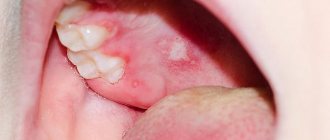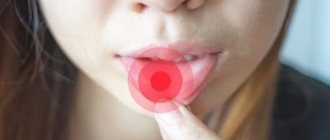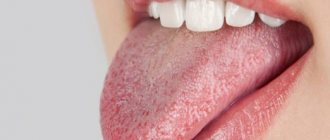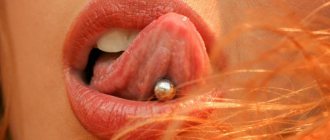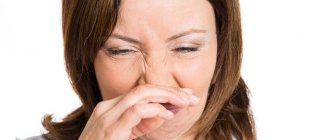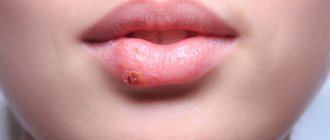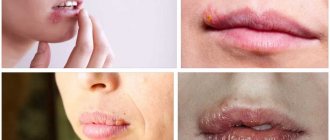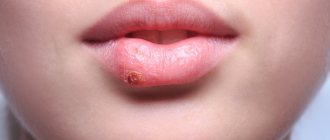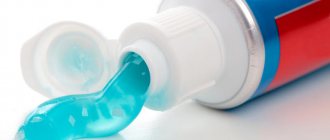September 23, 2021
Most often in medical practice, pathology caused by type 1 occurs. This is the so-called labial herpes (rash on the lips)
Herpetic infection is a chronic disease; once HSV enters the body, it remains in it, living in the nerve endings, for life. The herpes virus belongs to the Herpeveridae family, includes 8 types and three subfamilies: the Alphaherpesvirinae subfamily consists of herpes simplex viruses 1, 2 and varicella zoster virus; the subfamily Gammaherpesvirinae includes Epstein-Barr virus, HHV-VI, HHV-VII, HHV-VIII; the subfamily Bethaherpesvirinae constitutes type V, the Cytomegalovirus virus.
Most often in medical practice, pathology caused by type 1 occurs. This is the so-called labial herpes (rash on the lips). Its peculiarity lies in its chronic course; with adequate treatment of a patient with symptoms of labial herpes, it is possible to achieve stable remission. However, at this time the virus “hides” in the nerve nodes (ganglia), where it can be stored in an inactive form as long as necessary, and when “favorable” conditions arise, it is activated again.
The herpes simplex virus is present in the body of 95% of people, entering the body in early childhood: at 3 - 4 years, when the antibodies against the herpes virus transmitted to the baby by the mother are depleted. WHO estimates that in 2021, about 3.7 billion people under 50 years of age, or 67% of the world's population, were infected with HSV-1 (have oral or genital herpes). Prevalence rates were estimated to be highest in Africa (88%) and lowest in the Americas (45%). Most HSV-1 infections were oral infections.
Recurrent herpetic rashes occur due to prolonged exposure to the sun, febrile illness, physical or emotional stress, immunosuppression, and unknown causes. In general, recurrent rashes are less severe and less common.
Severe cases of the herpes virus include encephalitis, meningitis, neonatal herpes, and in immunocompromised patients, disseminated infection. Mucocutaneous infections cause clusters of small, painful blisters on an erythematous base.
Herpes is transmitted in the following ways: contact - physical contact with an infected person; airborne - through saliva particles when sneezing and coughing; sexually – genital herpes is most often transmitted this way. During unprotected sexual intercourse; household - through shared items (towels, dishes, bed linen); vertical - from a pregnant woman to a child during pregnancy or childbirth.
Herpes on the tongue (herpetic glossitis) - signs of the disease and methods of its treatment
There are a huge number of taste buds on the surface of the tongue. They allow us to enjoy the taste of our favorite dishes and drinks, recognize the temperature and consistency of food. In addition, language plays a very direct role in human communication, allowing us to communicate with each other. The appearance of an organ alone can tell a lot about a person’s state of health. Thick plaque, redness, swelling, pain - all these are signs of certain disorders in the functioning of internal organs and systems, and these problems require medical intervention. One of the common diseases of the organ is glossitis. Today we’ll talk about a separate type of this pathology, namely herpes on the tongue or herpetic glossitis. Read on to find out whether herpes occurs in the mouth, what this form of the disease is, what symptoms are typical for it and how to cure it.
What is glossitis
Glossitis is an inflammatory pathology of the tongue, which often begins due to banal injury to the organ and penetration of harmful microorganisms through an open wound. Hence the widespread prevalence of this disease, because all of us at least once in our lives accidentally bit our tongues while eating or talking. Another common prerequisite for the development of the disease is insufficient oral hygiene, which leads to the active proliferation of bacteria.
The photo shows glossitis of the tongue
Pathology can be either an independent phenomenon or a consequence of complex problems in the functioning of the body as a whole or a specific dental disease. If you ignore obvious symptoms for too long, things can end up with very serious complications.
Prevention of herpes
Prevention of herpes simplex comes down to fulfilling the following conditions to avoid the spread of viral infection in children's groups:
- isolation of a patient with a viral disease from the team, even with a mild degree of the disease;
- elimination of chronic foci of infection;
- prophylactic use of antiviral ointments during an influenza epidemic by putting it in the nose 1-2 times a day;
- taking desensitizing drugs during an influenza epidemic (diphenhydramine, suprastin, pipolfen, diprazine, tavegil, diazolin, fenkarol, etc.) in the amount of a one-time pediatric dose per day; preventive course – 3-5 days;
- hardening the child, walks and games in the fresh air, gymnastics.
Causes
The main provoking factors leading to the development of the disease in question have already been mentioned above. Let's look at all the most common causes of glossitis in more detail:
- damage to organ tissue: people often injure their tongue while eating, for example, with sunflower seed shells or fish bones. Injury can also result from accidental biting, the use of a worn-out prosthetic device, improper installation or adjustment of an orthodontic system to correct the bite, or damage to the mucosa from the sharp edges of a crown or filling. In addition, the cause of scratches and ulcers on the organ can be a burn or aggressive effects of acids contained in certain foods,
Tongue injury can cause pathology - long-term use of powerful medications, including antibiotics,
- allergies to hygiene products - toothpaste or mouthwash,
- disruptions in the functioning of the gastrointestinal tract: in this case, glossitis becomes a kind of symptom of a specific disease of the stomach or intestines, and here the help of a gastroenterologist will be needed,
- spread of infection - active spread of fungus or harmful bacteria in the oral cavity and esophagus,
- addiction to cigarettes and alcohol - the aggressive effects of tobacco smoke and alcohol on the oral mucosa in combination with a weakened immune system often leads to the development of various pathologies of the mucous membrane,
- acute deficiency of vitamins A and E.
This is what a fungal infection looks like on the tongue
. It is worth noting that glossitis quite rarely appears against the background of only one of the reasons described above. Typically, the development of pathology is facilitated by a whole range of problems associated with the condition of the oral cavity and the digestive tract, and injury to the organ becomes only a “trigger”. At risk are people whose professional activities involve constant contact with chemicals, as well as those who neglect to comply with hygiene rules.
Pimples on tongue
Pimples on the tongue are painful and cause discomfort, but they are easily treated and do not cause complications. A pimple on the tongue can appear for many reasons, most often due to microtrauma of the tongue, stomatitis or herpes. In principle, there cannot be acne on the tongue, since there are no sebaceous glands on it. Those formations that are mistaken for pimples are not actually pimples - they are not filled with purulent exudate. These are small swellings and ulcers on the surface of the tongue. They are white, pink, red, yellow, depending on the complexity of the disease and the cause of formation. Small pimples are very painful, they interfere with eating, talking and even bother the patient at rest.
White pimple on tongue
A white pimple on the tongue most often appears as a result of stomatitis or candidiasis. These two diseases are treated completely differently; you should consult a doctor at the first symptoms in order to correctly diagnose and prescribe treatment. Candidiasis is characterized by white pimples and a coating on the tongue, which in appearance resembles cottage cheese and covers the entire surface of the oral cavity. There are also white pimples on the base, tip and under the tongue.
With stomatitis, small pimples appear on the tongue. There are usually many of them, they can merge with each other. These small white pimples at the tip or root, at the base or underneath are very painful and itchy. The pain intensifies after eating. If such symptoms appear, you should consult a doctor to confirm the diagnosis and prescribe treatment. Treatment consists of antiseptic treatment of the surface of the oral cavity and lifestyle correction, since the main cause of stomatitis is insufficient oral hygiene.
Red pimple on tongue
Red pimples on the tongue are the main sign of glossitis, an inflammatory disease. Outwardly, they look like inflamed red dots that hurt.
Glossitis can appear for many reasons:
- Allergic reaction;
- alcohol abuse;
- eating too hot and spicy food;
- the presence of the herpes virus.
The appearance of yellow pimples on the tongue is usually not an independent disease. Often with stomatitis or candidiasis, the coating on the surface of the tongue takes on a yellowish rather than white tint. Yellow pimples most often also mean either candidiasis or stomatitis.
Pink pimples on the tongue , like yellow ones, are not an independent disease. Usually they are an early stage of glossitis, when the inflammatory process has not yet reached its peak. If pink acne appears, you should immediately consult a doctor for advice.
The main causes of acne:
Mechanical damage
In the process of chewing or biting food, we bite our tongue, resulting in a slight mechanical injury. The risk of surface damage increases when consuming hard foods with sharp edges (crackers, chips, seeds). A small painful swelling or bump forms at the site of the injury, which after some time turns into a white pimple.
You should exclude spicy and hot foods from your diet, carefully monitor oral hygiene, and after a few days the pimple will disappear on its own.
Allergic reaction
An allergic reaction is possible to food, medicine or toothpaste. This causes small white pimples and sores to form that hurt and irritate when eating or drinking liquids. If your doctor suspects an allergy, it is very important to identify the allergen and eliminate it from your diet.
Stomatitis
Stomatitis is a common cause of white or red pimples on the surface of the tongue. The main cause of stomatitis is insufficient oral hygiene, exposure to pathogenic bacteria on the mucous membranes due to dirty hands, unwashed fruits and vegetables. Most often, children suffer from stomatitis, because they tend to put everything in their mouth. At the first suspicion of stomatitis, you should consult a doctor, he will prescribe medications that relieve itching and soreness of the tongue, as well as promote the speedy healing of ulcers and pimples.
Herpes
Herpes can affect all mucous surfaces of the human body, including the oral cavity. In this case, watery pimples may appear on the tongue and inner surface of the cheeks. Without proper treatment, herpes can eventually affect the entire body, including the brain. Therefore, if you have a herpes virus, you should consult a doctor and undergo a course of antiherpetic therapy.
Poor nutrition
If you eat too much spicy and hot food, inflammation of the tongue, or glossitis, may occur. Drinking alcohol in large quantities, as well as smoking, can cause inflammation of the tongue. Therefore, when the first problems appear, you should immediately try to get rid of bad habits.
Pathologies of the patient's internal organs
Pimples on the tongue can be a manifestation of various diseases, including candidiasis or tuberculosis. If a pimple does not go away for a long time, be sure to consult a doctor.
Weakened immunity
If the immune system is weakened as a result of a previous illness or due to a lack of vitamins and microelements, small painful pimples may appear on the surface of the tongue. It is necessary to take immunomodulators, as well as drugs with lactobacilli to normalize intestinal function and correct the activity of the immune system.
You can only get rid of a pimple on your tongue using comprehensive measures. It is necessary to consult a doctor to determine the true cause of its occurrence. The oral cavity should be kept clean, preferably rinsed with a soda solution or a decoction of St. John's wort. It is also necessary to strengthen the immune system and limit the consumption of spicy and too hot foods so as not to irritate the inflamed nodule.
A pimple at the base of the tongue makes it difficult to swallow and even talk; it hurts and causes a lot of trouble. It could be stomatitis, a fungal infection, a sore throat or pharyngitis. Only an experienced doctor can make a correct diagnosis.
A pimple on the tip of the tongue can pop up at the site of a microtrauma as a result of an infection entering the wound.
In any case, it is advisable to consult a doctor and get tested to make an accurate diagnosis.
For any questions, please call: +7 (343) 2000 730; +7 We work daily, without breaks: Mon-Sat 09.00-21.00 Sun 10.00-20.00 We are waiting for you at the address: Ekaterinburg, st. Gottwald 14a, office 6. Dentistry "MK DENT"
Herpetic form - features
One of the most common forms of the pathology in question is the so-called herpetic or herpetic glossitis. In this case, the development of the disease is caused by the herpes simplex virus. A distinctive symptom of this type of disease is the appearance of rashes in the form of watery blisters that appear on the surface of the organ - they can appear at the tip, directly at the root, under the tongue and even on the frenulum.
Herpetic form of glossitis
The tumors are very painful and cause a burning sensation, especially when eating. Herpetic glossitis is a serious disease that requires timely treatment. Like the herpes virus, this disease is extremely contagious, so during treatment it is better to isolate the patient, if possible, from contact with other people.
Types of herpes and provoked diseases
Experts identify several types of herpes viruses:
- the varicella zoster virus, which causes shingles and chickenpox;
- herpes simplex virus type 1, which causes the classic blistering rash on the lips;
- herpes simplex virus type 2 leads to the appearance of genital herpes and dangerous complications for the reproductive health of women and men;
- Epstein-Barr virus, which causes infectious mononucleosis;
- a herpes virus that causes cytomegalovirus infection.
The virus resides in the nerve cells of the trigeminal nerve until a situation occurs that provokes its reactivation. Infection usually occurs at an early age through the respiratory tract or close household contacts. Herpes simplex type 2 has oncogenic properties and can cause the development of cervical cancer and malignant lesions of other genital organs. After the first sexual intercourse and infection, clinical manifestations can be smoothed out, but the virus remains in the ganglia for the rest of life.
Appearance in children
The risk of developing herpes on a child’s tongue is increased by the fact that young children constantly put various objects in their mouths. Unfortunately, very often this disease manifests itself in children. In this case, the herpetic form of pathology is not the most common, because more often children have to deal with catarrhal inflammation, which is caused by injury to soft tissues due to constant biting, wearing an orthodontic plate and burns from eating too hot food.
“We had glossitis last winter. I noticed purple ulcers on the tip of my daughter’s tongue, I grabbed her and ran to the doctor. The child admitted to the dentist that her tongue began to tingle, but just the other day, that is, we managed to contact her at a very early stage. The doctor prescribed us pills and rinses with chamomile solution. We recovered in about a week.”
Oksana N., Omsk, from correspondence on the woman.ru forum
Stomatitis is common in infants.
An open wound on the oral mucosa opens a direct path for the penetration of harmful microorganisms. As a result of the development of the disease, the child may experience pain and burning in the organ. Another common type of glossitis in children is the candidal form - it occurs most often in the youngest.
Symptoms of the herpes virus
Herpes simplex virus 1 causes oral and, less commonly, genital herpes. Such herpes is characterized by the formation of small blisters in the amount of one to ten pieces, they are located in groups, and inside are filled with serous exudate. Gradually, the blisters open, and in their place crusts form, which disappear on the 6th day of the disease.
After this, subtle pigmentation remains, which goes away independently and without a trace at the end of recovery. Typical clinical picture: the formation of painful blisters filled with serous fluid in the lip area; itching and burning in places where skin elements appear; loss of appetite, increase in body temperature (rare). With adequate treatment, signs of the disease can disappear after 3-4 days.
The formation of blisters is accompanied by severe itching, pain and burning at the site of the pathological process. Systemically, fever and enlarged lymph nodes may occur. With oral herpes, the blisters are localized around the mouth and wings of the nose. The genital form of the disease manifests itself with characteristic symptoms on the mucous membrane of the genital organs.
A typical sign of genital herpes is the appearance of small (2-5 mm), fluid-filled blisters on the genitals, buttocks and anus. The rash is accompanied by itching and/or pain. The rash can be located in the vagina, on the cervix, or in the rectum. Within a few days, the blisters burst, turning into painful sores. After 1-2 weeks, the ulcers become covered with crusts and heal. Other manifestations: pain in the groin or inner thighs, painful urination, vaginal discharge in women or from the urethra in men.
Primary infection lasts about 3 weeks with pronounced manifestations. After the initial episode of the disease, exacerbations occur several times (usually 4–5) during the year. In the future, the number of exacerbations decreases, the severity of manifestations decreases.
During pregnancy
Glossitis in a pregnant woman usually develops against the background of weakened immune defenses of the body. The lack of a balanced diet coupled with a lack of vital vitamins and microelements often provokes vitamin deficiency, and glossitis becomes one of the associated pathologies. Other provoking factors during this period may be exacerbations of diseases of the gastrointestinal tract, as well as damage to the oral mucosa due to frequent vomiting against the background of toxicosis.
Treatment of the disease during pregnancy is carried out in such a way that the negative impact on the body of the mother and child is minimal. To do this, the specialist selects effective and at the same time safe medications, usually of local action - lozenges and lozenges, all kinds of rinsing solutions.
How is diagnostics carried out?
The appearance of neoplasms on the tongue of an adult or child should at least alert you. If redness, pain and swelling are added to everything else, it’s most likely glossitis. However, to make an accurate diagnosis and choose the appropriate treatment method, you must consult a doctor. Already as part of the initial visual examination, the specialist will be able to draw certain conclusions regarding the clinical picture, and to identify the specific cause of inflammation, it may be necessary to undergo the following types of examination:
- general blood analysis,
- blood chemistry,
- scraping from the damaged area.
Only tests can determine the true cause of the problem.
Only with the results of the studies in hand, the doctor will be able to make a final verdict and prescribe the necessary therapy. Do not self-medicate under any circumstances - such arrogance can lead to a worsening of the situation.
How is the disease treated?
Treatment of herpes on the tongue can be quickly and effectively provided only by a doctor after making an accurate diagnosis and identifying a specific form of pathology. And in each individual case, the treatment method will largely depend on the individual clinical picture. Below are several general principles for combating the disease:
- elimination of all accompanying pathologies of the oral cavity - treatment of carious cavities, removal of plaque and dental deposits,
- rinsing with antiseptic solutions - Miramistin, Laripront, Chlorhexidine, Furacilin. If there is an advanced stage, the doctor may prescribe a course of antibiotics,
- compresses - it is recommended to smear the affected areas with products that promote wound healing and eliminate pain. Among such ointments are “Kamistad”, “Vinizol”, “Malavit”, “Solcoseryl” and others1,
- treatment with oils: experts advise treating the affected areas with oil, for example, rosehip or sea buckthorn - they perfectly help in normalizing the microflora of the oral cavity,
- multivitamin complexes: taking healthy vitamins and minerals is necessary to restore the body's defenses.
The recommendations described above are relevant for most forms of glossitis, however, targeted therapy is necessary to effectively eliminate the disease.
Dietary recommendations
During treatment, experts advise following a certain diet. You should avoid foods that irritate the mucous membrane. Here are some important recommendations:
- give up too solid foods,
- food should be at room temperature,
- eat only fresh fruits and vegetables,
- It is better to exclude hot spices and acidic foods,
- limit the number of cigarettes you smoke and give up alcohol,
- exclude pickles and smoked products.
You should also avoid sweets if possible. Excessive sugar consumption during this period can lead to intensive proliferation of microbes in the oral cavity.
Possible complications
If no attempts are made to cure the disease, over time the lesion will spread further to the mucous membrane and will inevitably lead to serious health problems in general. In the worst case scenario, there may be a threat of an abscess, and it will have to be removed surgically. In this case, the person will experience throbbing painful sensations, and the tongue will increase in size, unevenly.
The photo shows a tongue abscess
How to treat a disease with folk remedies
Treatment of herpetic glossitis at home can only be as a concomitant therapy. To put an end to the problem once and for all, you need competent diagnosis and the help of a specialist. Let us remind you: only a doctor has the right to prescribe medications, and without his consent, you should under no circumstances make any attempts to cure the disease yourself. All this can end not only in vain, but also very disastrously.
If the specialist has given the go-ahead for the use of traditional methods, you should pay attention to medicinal herbs. For example, tea tree oil effectively promotes the restoration of mucosal tissue. Also, in the fight against glossitis, rinsing with a decoction of chamomile and a light solution of hydrogen peroxide have proven themselves to be excellent.
Treatment of herpes:
- Anesthesia (egg white + 2% novocaine, anesthesin + peach oil, 0.5-1% solution of trimecaine or lidocaine, 4% solution of pyromecaine on glucose, 0.5-1% solution of novocaine with urotropine,).
- Enzymes (trypsin, lysozyme, chymotrypsin, chymopsin, pancreatin, deoxyribonuclease)
- Antiseptic treatment (0.5-1% hydrogen peroxide solution, 0.06% chlorhexedine solution). Parents' signature: Ivanova.
- Antiherpetic ointments (0.25% oxaline ointment, 1% florenal, 0.5% tebrofen, 1% riodoxol, as well as 3% gossypol liniment, 0.1% gossypol solution, 0.5% bonaftone ointment, 5% interferon ointment, ointments Zovirax and acyclovir). All this 5-6 times a day. This is done for 4-5 days.
- 6th day.
- leave as needed.
- No need.----
- we leave it too.
- keratoplatics (vitamin A in oil, vitamin E in oil, Shostakovsky balm, carotolin, rosehip oil and sea buckthorn oil, vitaon)
Preventive measures
To avoid the development of such an unpleasant and even dangerous disease as herpetic glossitis, you should adhere to the following tips and recommendations:
- you need to carefully care for your oral cavity, brush your teeth and tongue twice a day, rinse your mouth every time after eating,
- It’s better to stop smoking and drinking alcohol at least for a while,
- it is necessary to carefully control your diet, avoid too salty, spicy and sour foods, cold and hot dishes and drinks,
- it is important to regularly undergo preventive examinations not only with a dentist, but also with a gastroenterologist and immunologist,
- At the first symptoms of pathology, you should immediately seek medical help.
Regular brushing of teeth and tongue will help reduce the risk of disease.
Any form of glossitis, including herpetic, in the vast majority of cases develops against a background of weakened immunity. Therefore, an equally important condition for maintaining complete disease prevention is a healthy lifestyle. Walk outdoors more often, play sports, eat right, and don’t forget to take a responsible approach to oral hygiene.
- Borovsky A.L. Diseases of the mucous membrane of the oral cavity and lips, 2001.
Treatment of herpes
Treatment of herpes simplex should be comprehensive, ethionatogenetic.
General treatment of herpes
- High calorie diet.
- Drink plenty of fluids.
- General restorative therapy - vitamin C, calcium supplements (calcium gluconate, calcium glycerophosphate, calcium lactate, calcium chloride), fish oil for 1-2 weeks. Doses are selected individually, taking into account the age, weight and general condition of the child.
- Desensitizing therapy (diphenhydramine, suprastin, pipolfen, diprazine, tavegil, diazolin, fenkarol, etc.) for 1-2 weeks
- Antiviral drugs (bonafton, tebrofen, florenal, Megosin, alpizarin, remantadine, metisazone, riodoxol, gossypol, leukocyte interferon, biosynthetic leukocyte drug interlock, deoxyribonuclease, interferon, helepin, modimunal, acyclovir, Zovirax, Virolex) for oral and local administration in the form of applications. The dose is selected individually according to the age, weight, and general condition of the child.
- Immunocorrective therapy. Gamma globulin or histaglobin is prescribed 1-2 ml intramuscularly 2 times a week, for a course of 1-2 injections, to increase the body's defenses. You can use dekaris, taktivin, timoptin (the dose is selected individually according to the age, weight of the child and based on the general condition), Immunal - 5-15 drops, 2-3 times a day for 1-2 weeks (the dose is selected individually according to the age of the child ).
- A specific antiherpetic polyvaccine (during the period between relapses), the combined administration of a vaccine and parenteral administration of interferon inducers (ridostine) are effective.
Local treatment of herpes
- The oral mucosa should be anesthetized with warm anesthetics, then antiseptically treated with warm antiseptics, in particular 0.5-1% solution of trimecaine or lidocaine, 4% solution of pyromecaine on glucose, 0.5-1% solution of novocaine with urotropine, 5-10 % anesthetic emulsion, 0.02% furatsilin solution, 0.02% ethacridine lactate solution, 0.01% dimexide solution, 0.1% etonium solution. It is possible to use an antiseptic together with an anesthetic in a 1:1 ratio (the solution is prepared before use) in the form of irrigation, baths, applications 3-4 times a day.
- Applications of proteolytic enzymes are carried out once a day for 5-10 minutes. It is recommended to use lysozyme, chymotrypsin, chymopsin, pancreatin, deoxyribonuclease, which has not only a cleansing effect of necrotic masses, but also an antiviral effect.
- Applications of antiviral ointments are used 3-4 times a day for 10-15 minutes. It is recommended to use 1% florenal, 0.5% tebrofen, 1% riodoxol and 0.5-1% oxolinic ointments, as well as 3% gossypol liniment, 0.1% gossypol solution, 0.5% bonaftone ointment, 5% interferon ointment , ointments Zovirax and acyclovir. Interferon in solution should be instilled into the oral cavity and each nostril, 1-2 drops 3-4 times a day. The course of treatment is individual for each child.
- Applications of keratoplasty preparations should be prescribed from the moment of epithelization of erosions 2-3 times a day for 10-15 minutes (vitamin A in oil, vitamin E in oil, Shostakovsky balm, carotolin, rosehip oil and sea buckthorn oil). The course of treatment is individual for each child.
- They also use applications of agents that stimulate local immunity (1% sodium nucleinate solution, 5-10% galascorbine solution, 5% methyluracil ointment, 10% methyluracil emulsion), for 10-15 minutes 2-3 times a day. The course of treatment is individual for each child. In addition, iimudon is prescribed, a drug prepared from a mixture of lysates of various microorganisms and which is a polyvalent complex of antibodies. It stimulates the defenses of the oral mucosa by increasing the activity of polymorphonuclear leukocytes, increasing the number of slgA, increasing the activity and content of lysozyme in the oral fluid. Immudon is prescribed in the form of tablets for resorption in the oral cavity, 5-8 pieces per day. The course of treatment is 10-16 days. In the acute period, during the period of exacerbation and with severe pain - 8 tablets per day. In the remission phase, the drug should be used as a prophylactic agent, 5 tablets per day for 2 weeks.
- Physiotherapeutic treatment is prescribed from the first day of the disease (irradiation with a heliumene laser or ultraviolet No. 3-5) daily or every other day.
